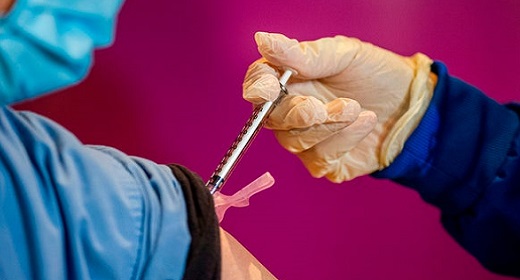by Robin Lloyd: Pandemic highlights for the week…
Why are SARS-CoV-2 infection rates and COVID-19 hospitalizations dropping so rapidly these days in the U.S.? A 2/17/21 story by Derek Thompson at The Atlantic reports that it’s a combination of better social distancing, increased mask-wearing, seasonality, a growing number of people in the U.S. who have developed antibodies after infection with the virus (15% to 30% of U.S. adults), and the growing number of people in the U.S. who have been vaccinated against COVID-19. “We’re accelerating toward a moment, sometime this spring, when half of American adults should have some kind of coronavirus protection,” Thompson concludes.
For a quick dive into key outcomes from large-scale COVID-19 vaccine studies conducted by Pfizer/BioNTech, Moderna, AstraZeneca, Novavax, Johnson and Johnson, and Gamaleya Sputnik V, see Yale University immunologist Akiko Iwasaki’s 2/7/21 Twitter thread featuring comparative tables, made by Yale Medical School students. “All the tables here…indicate the # COVID-related death in the vaccinated as the right-most column (which is ZERO).” She adds: “With all these vaccines…we can bring down the number of severe & lethal Covid. The variants are here, but current vaccines still protect from severe disease & vaccines for the variants are coming. We will get through this!”
A 2/16/21 story by Ariana Remmel for Nature includes bar charts that illustrate the frequency of side effects reported to the U.S. Centers for Disease Control among people who have received the Pfizer/BioNTech vaccine against COVID-19. The chart shows that fatigue is reported by 29% and 50% of people receiving their first- and second-dose, respectively; headaches are reported by 26% and 42% of people receiving their first- and second-dose, respectively; and fever is reported by 7% and 25% of people receiving their first- and second-dose, respectively. People report more side effects to this vaccine and to Moderna’s COVID-19 vaccine than they do to flu vaccines, according to an infectious-disease specialist at the University of Washington School of Medicine, the story states. The piece also states that the frequency of anaphylactic (severe, allergic, and life-threatening) reactions to the Moderna vaccine is three per million doses, and it’s 30 per 3 million doses so far for the Oxford-AstraZeneca vaccine. All these individuals have “fully recovered,” per the story. Anaphylaxis is treatable if caught quickly, according to Paul Offit, a vaccine specialist at Children’s Hospital of Philadelphia who is quoted in the story. Remmel writes: “There is no question that the current vaccines are effective and safe. The risk of severe reaction to a COVID-19 jab, say researchers, is outweighed by the protection it offers against the deadly coronavirus.”
Epidemiologist Katelyn Jetelina of the University of Texas Health Science Center at Houston published a 2/14/21 post at her Your Local Epidemiologist site that summarizes the latest evidence for drugs to treat COVID-19. The post is based on a 280-page report on COVID-19 treatment options published 2/11/21 by the U.S. National Institutes of Health. Two options shown by studies to work so far: steroids called corticosteroids (specifically, they protect against death from severe COVID-19 and decrease how long you have to stay in an intensive care unit), and the anti-viral drug remdesivir (it’s protective for hospitalized patients who need supplemental oxygen, other than ventilators). The post includes a 12/10/20 chart published in the British Medical Journal that summarizes the experimental results of many of the drugs tested against COVID-19. The post also summarizes the evidence for “drugs that are making headlines,” but it suggests there currently is not enough evidence to support giving them to COVID-19 patients (e.g. ivermectin, arthritis drug tocilizumab, and asthma drug budesonide).
COVID-19 might have humbled Peter Diamandis, entrepreneur and founder of the X Prize Foundation, he suggests in a 2/12/21 blog post. Takeaway: despite high-quality pre-arrival and daily testing, a gathering of what sounds like about 100 people for a conference turned into a superspreader event that infected about a quarter of attendees. A group of audiovisual and production technicians who kept to themselves and reportedly wore masks throughout the event was spared. Diamandis writes: “Masks Work.”
The “bona fide nerdy girls” at Dear Pandemic (specifically, they are an interdisciplinary all-female team of researchers and clinicians who work in nursing, health policy, and epidemiology among other fields) are now publishing Spanish-language COVID-19 information at a Facebook page called Querida Pandemia.
The UnbiasedSciPod, a podcast co-hosted by Jessica Steier, a public health researcher and data scientist, and Andrea Love, an immunologist and microbiologist, posts some helpful graphics at its Instagram page, including this one on 2/11/21 showing updated U.S. Centers for Disease Control recommendations that pertain to people who’ve been vaccinated and later exposed to someone thought to be infected with SARS-CoV-2 or to have COVID-19. If you fall within two-weeks and three months of receiving your final vaccine dose and have no symptoms following contact with someone who has the virus or COVID-19, you no longer are required to quarantine, per the post. But you still “must continue wearing a mask and practicing social distancing,” it states.
You might enjoy “I’ve never tried your idea, and now everything is on fire, and that’s how I know your idea is bad,” by Eli Grober (1/17/21) in McSweeney’s.

















































